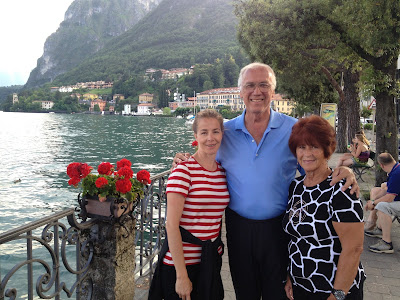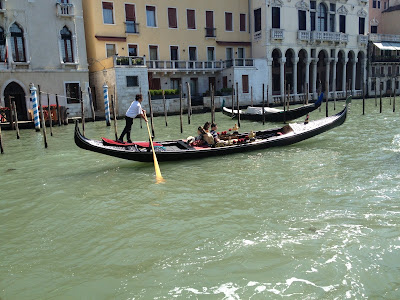I now know why Switzerland exists: it's to make to the other european countries seem affordable. Your eyes do not deceive you: that menu above does indeed show a cheeseburger with fries for 17.50 Swiss francs--about $19. For one late dinner in Switzerland, we laid out $80 for six bowls of soup and three plates of French fries. It was perhaps a good thing that the restaurant's kitchen was closed at 8:00 pm (we arrived at about. 8:15), so all they would serve us was french fries and tomato soup. I can only imagine what it might have cost us if we had actually ordered from the menu.
I am anxious to learn from an economist why everything here is so expensive. It can't be because its so incredibly beautiful. There are lots of incredibly beautiful places in Europe. It can't be just because the Swiss Franc, which is issued by perhaps the only european country with a balanced budget, is a strong currency. It can't be because its landlocked. I actually googled that question and in the 15 minutes I had to search for an answer, I only found some conspiracy-theory types who offered some lame explanations for the expensiveness of Switzerland. If you happen to know the answer, please fill me in.
The Lauterbrunnen Valley in Switzerland was on the top of my must-sees for this journey. There was so simply no way I would have missed it. Lisa and I travelled her 15 years ago at the suggestion of my good friend Scott Lambert. We spent three idyllic days in what I came to believe was the most beautifully majestic place on earth. When we were here last the weather was perfect with barely a cloud in the sky, lots of sunshine, and clear air that let us see every possible mountain peak in the region. At the time, we strolled leisurely through fields of mountain flowers in the full sunlight through the charming towns of Gimmelwald and Murren that sit atop what must be 2,000+ foot cliffs above the floor of the glacier-cut Lauterbrunnen Valley floor. The thought didn't even dawn on me that it might be cold an rainy at the end of June, 2013. I guess I didn't plan well enough--there's a reason that area is so spectacularly green, lush, and filled with water. It must rain here often.
And rain it did--for three days with temperatures in the 50's and low 60's in the day, and colder at night. Lots of clouds, suppressed views, and lots of longing for 15 years ago. It is funny how our memories of the past come somehow blind us from the glory of the present. For example, take a look at these pictures below. If you experienced this would you feel sorry for yourself (as I did for the first 48 hours of my visit):
Of course you wouldn't feel sorry me. And I shouldn't have either, but I did. For two days, I was just sick that I couldn't see what I had seen before. There were two excursions that I had to cancel due to weather (1) a visit to the Shilthorn and it's revolving restaurant at about 10,000 feet that gives you panoramic views of all the major peaks of these parts of the alps (not to mention the incredible views of the Lauterbrunnen area that it gives you as you ascend from the valley floor in a high speed tram); (2) the Jungfraubahn--a train that takes you straight up a mountain to a train station at 11,500--nearly the top of the Jungfrau peak: another incredible experience from our 1998 trip.
Both of these excursions are incredibly expensive (98 francs round trip for the Shilthorn and 172 francs for the Jungraubahn, which can be cut to 135 if you leave around 7:30 am), and worth doing when you can see anything due to cloud cover. We almost did the Shilthorn in bad weather because part of the fun of that excursion that I was looking forward to was hiking down from the top (which also cuts the fare by a big margin because you only need to pay for one way). I figured that despite the fact we could see anything from the top that the journey on the way down would be fun, passing through flower-filled mountain meadows, warming huts, and several little villages that dot the mountainside all the way down to the valley floor.
When I went to buy tickets for the group, the guy at the lift station talked me out of it (imagine that), saying that it just wasn't worth the money in this weather--he explained that to me as he showed me live-cam shots of the blizzard at the top of the Shilthorn. So, despite the cold and rain, we pressed on and did a shortened version of my hike.
We bought tickets to Muren (on a shelf 2,000 feet above Lauterbrunnen), and then took a Funicular to a place called Allmendhubel, a small summit above Murren, which leads to a very easy, family-friendly walking trail down to Murren--an excursion that takes about 1.5 hours, and leads one through incredible scenery of mountain meadows full of flowers, sheep, quaint villages, the clearest water you've ever seen, and even a children's adventure park, complete with a free zipline. This easy little walk made our trip, and left me hungry for more mountain wandering. There are hundreds of great trails in this region that I wish I had a week or two (or more) to explore.
By the end of the walk I no longer felt sorry for myself, but instead felt grateful that we had the experience we did with this mountain. I forgot about 1998, and just felt happy to be in 2013. It was simply stunning--terrible weather and all.
Finally, there was one part of our trip to Switzerland that didn't cost me an arm and leg. Instead of paying a small fortune to stay in the charming towns of Murren or Gimmelwald, I found a little town to the north of Murren and Gimmelwald--on the same shelf of above the valley--called Isenfluh. This charming little village of probably 20 homes was superb. For one, you can drive to it via a tunnel that the undaunted swiss built that carves its way through the cliff and up to the shelf aobve. Secondly, no one has ever heard of it, which makes it totally un-touristy, quiet, and relatively inexpensive. You want rent an apartment for about 600 francs for the week there. We stayed at the Chalet Daheim (click here for a peak), which is the right side of the home of a non-English speaking, old swiss dude, who, like most Americans, thinks that if you keep saying the same thing in your own language--just more loudly and more slowly--that your foreign guest can understand you.
Though my Dutch helped me understand 15% of what he was saying, it wasn't enough to make the communication very fruitful, but it was certainly eventful and entertaining. Fortunately, his english-speaking daughter handles all reservations inquiries and questions, which is frankly most of what matters. The other questions one might ask such as--how do you turn on the dishwasher, washing machine, heater, and why is there no more hot water?--you finally understand through hand gestures, charades, and the drawing of stick figures. While Lisa, who likes her personal space, didn't care for the kiss she received from our old, swiss host (granted, he planted it on her cheek when I wasn't there, so maybe I should have been worried), I found the old man a hoot, and doubt he was trying to hit on my hot wife.
Weather notwithstanding, our trip to Switzerland was still memorable. And yes, we can't wait to come back. I'm just waiting for someone to give me an excuse to return: anyone in?
Final shots from Switzerland:
Outside our place in Isenfluh
Wandering in Murren
Gotta love that Swiss ambiance--cowbells and all.
Snow at the end of June on our way from Lake Como to the Isenfluh
Scott, this is for you.
Grandma and Grandpa--view from Murren
Abby was proud of the bouquet she picked





















































